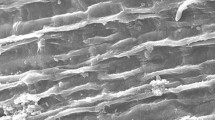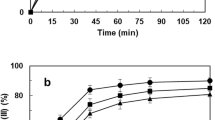Abstract
The biosorption mechanism of Cr (VI) ions on Synechococcus sp. biosorbent was studied by analyzing the biosorption kinetics as well as speciation change and bond formation during the biosorption process. The kinetics study shows that the adsorption process of Cr (VI) consists of a very fast stage in the first several minutes, in which more than half of the saturation adsorption is attained, and a slower stage that approximately follows the first order kinetic model, basically Freundlich isotherm models were observed. Comparative studies of FT-IR spectra of K2Cr2O7, free cells of Synechococcus sp., and Cr-bound cells of Synechococcus sp. show that the speciation of chromium that binds to the cells of Synechococcus sp. is Cr (III), instead of Cr (VI), and the carboxylic, alcoholic, amido and amino groups may be involved in the binding of Cr (III). Integrative analyses of the surface electric potential, the effect of pH value on adsorption behavior of Cr (VI), and the results of FT-IR show that the biosorption of Cr (VI) follows two subsequent steps, biosorption of Cr2O7 2− by electrostatical force at the protonated active sites and reduction of Cr2O7 2− to Cr3+ by the reductive groups on the surface of the biosorbents.
Similar content being viewed by others
References
BAILEY S E, OLIN T J, BRICKA R M, et al. A review of potentially low-cost sorbents for heavy metals[J]. Water Res, 1999, 33(1): 2469–2479.
ECCLES H. Removal of heavy metals from effluent streams-Why select a biological process[J]. Int Biodeterior Biodegrad, 1995, 35: 5–16.
VOLESKY B. Advances in biosorption of metals: Selection of biomass types[J]. FEMS Microbiol Rev, 1994, 14(2/3): 291–302.
DONMEZ G, AKSU Z. Removal of chromium (VI) from saline wastewaters by Dunaliella species[J]. Process Biochem, 2002, 38(5): 751–762.
CHOJNACKA K, CHOJNACKI A, GÓRECKA. Trace element removal by Spirulina sp. from copper smelter and refinery effluents[J]. Hydrometallurgy, 2004, 73(1/2): 137–153.
EL-SHEEKH M M, EL-SHOUNY W A, OSMAN M E H, et al. Growth and heavy metals removal efficiency of Nostoc muscorum and Anabaena subcylindrica in sewage and industrial wastewater effluents[J]. Environ Toxicol Pharmacol, 2005, 19: 357–365.
GUPTA V K, SHRIVASTAVA A K, JAIN N. Biosorption of chromium (VI) from aqueous solution by green algae Spirogyra species[J]. Biotechnol Bioeng, 2001, 35(17): 4079–4085.
GARDEA-TORRESDEY J L, ARENAS J L, WEBB R, et al. Ability of immobilized cyanobacteria to remove metal ions from solution and demonstration of metallothionin genes in variuos strains[J]. J Hazard Substance Res, 1997, 1(3): 1–18.
GARDEA-TORRESDEY J L, ARENAS J L, WEBB R, et al. Determination of the ability of inactivated and immobilized cells of Synechococcus PCC 7942 (Cyanobacteria) to uptake metal ions from solution[C]// ERICKSON L E, RANKIN M M, GRANT S C, MCDONALD J P. Proceedings of the 12th Annual Conference on Hazardous Waste Research. Manhattan; KS, Building Partnerships for Innovative Technologies, Kansas State Univ, 1997: 16–32
YU Xia, CHAI Li-yuan, MIN Xiao-bo. Removal of lead in wastewater by immobilized inactivated cells of Rhizopus oligosporus[J]. J Cent South Univ Technol, 2003, 10(4): 313–317.
XIA Jin-lan, SHEN Li, et al. Camparative study of biosorption of Cr(VI) onto free and immobilized cells of symechococcus sp[J]. J Cent South Univ Technol, 2006, 37(2): 241–246.(in Chinese)
CARMONA M E R, da SILVA M A P, LEITE S G F. Biosorption of chromium using factorial experimental design[J]. Process Biochem, 2005, 40(2): 779–788.
TOBIN J M, ROUX J C. Mucor biosorbent for chromium removal from tanning effluent[J]. Water Res, 1998, 32(5): 1407–1416.
SAG Y, KUTSAL T. The simultaneous biosorption of Cr(VI), Fe(III) and Cu(II) on Rhizopus arrhizus[J]. Process Biochem, 1998, 33(5): 571–579.
DÖNMEZ G Ç, AKSU Z, ÖZTÜRK A, KUTSAL T. A comparative study on heavy metal biosorption characteristics of some algae[J]. Process Biochem, 1999, 34(9): 885–892.
EATON A D, CLESCERI L S, GREENBERG A E. Standard methods for the examination of water and waste water[S]. American Public Health Association (APHA), AWWA, WPCF: Washington, DC, 1995: 4–23.
CRIST H R, OBERHOLSER K, SHANK N, et al. Nature of bonding between metallic ions and algal cell walls[J]. Environ Sci Technol, 1981, 15(10): 1212–1217.
ÖZER A, ÖZER D. Comparative study of the biosorption of Pb (II), Ni (II) and Cr (VI) ions onto S. cerevisiae: Determination of biosorption heats[J]. J Hazard Mater, 2003, 100(1/3): 219–229.
NURBA M, NOURBAKHSH S, KILIÇARSLAN S. Biosorption of Cr6+, Pb2+ and Cu2+ ions in industrial waste water on Bacillus sp.[J]. Chem Eng, 2002, 85(2/3): 351–355.
SUDHA S R, ABRAHAM T E. Biosorption of Cr(VI) from aqueous solution by Rhizopus nigricans[J]. Bioresour Technol, 2001, 79(1): 73–81.
PALMIERI M C, GARCIA JR O, MELNIKOV P. Neodymium biosorption from acidic solutions in batch system[J]. Process Biochem, 2000, 36(5): 441–444.
CHANG Xiu-lian, WANG Wen-hua, WEN Shao-hong. Investigation of cadmium(II) biosorption on shrimp shell[J]. Ion Exchange and Adsorption, 2002, 18(3): 241–248. (in Chinese)
Author information
Authors and Affiliations
Corresponding author
Additional information
Foundation item: Project(50321402) supported by the National Natural Science Foundation of China
Rights and permissions
About this article
Cite this article
Shen, L., Xia, Jl., He, H. et al. Biosorption mechanism of Cr (VI) onto cells of Synechococcus sp.. J Cent. South Univ. Technol. 14, 157–162 (2007). https://doi.org/10.1007/s11771-007-0032-1
Received:
Accepted:
Published:
Issue Date:
DOI: https://doi.org/10.1007/s11771-007-0032-1




